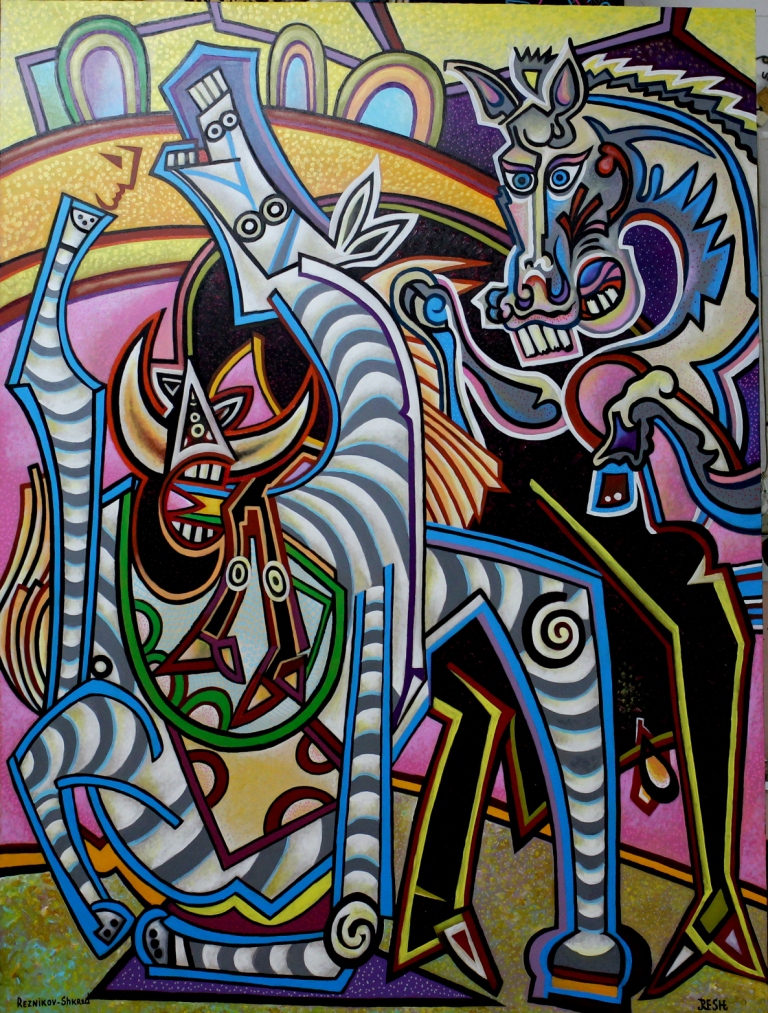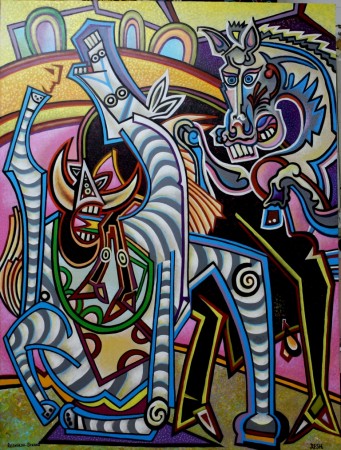Cubism in painting: history of occurrence.
The history of Cubism in painting has its origin from the “Les Demoiselles d’Avignon” by Pablo Picasso, written in 1907 under the influence of African sculpture and works by Paul Cezanne … In the early twentieth century art (and not only) there is a global revolution: artists, ignoring the conventions of academic schools realism, experimenting with shapes, colors, applications and other means of expression. As a result, a number of trends in contemporary art. One of them is Cubism.
Figures of girls in the picture shown in outline, chiaroscuro and perspective are absent, the background is shattered into fragments of different shapes. Then, in 1907 Pablo Picasso meets a young, but has already shown good results in Fauvism (another modernist direction of the early twentieth century), painter Georges Braque. Together they are the founders of a new direction in art – cubism. Conduct regular meetings, discussions, exchanging findings.
The name “Cubism” appeared in 1908, when the art critic Louis sat down called the new pictures of Marriage “bizarreries cubiques”, which translated from French means “cubic quirks.” To join a new direction painter Juan Gris, Marie Laurencin, Fernand Leger. For several years, in the style of “cubism” start working Robert Delaunay, Albert Gleizes, Henri Le Fauconnier, Jean Metzinger, Francis Picabia and others.
Paul Cezanne and his role in the emergence of Cubism Cubism The first period is called “Cezanne”. Artists Cubists continue the experiment by Paul Cezanne (1839-1906) with the form, perspective, finding new composite solutions.
Painting “Pierrot and Harlequin” was written by Paul Cezanne in 1888, ie, 19 years before the emergence of Cubism as a separate direction. In this paper we study the artist traced geometric shapes (circles, ovals and diamonds), the direction of drawing lines to some point, as well as custom angle. Perspective shows wrong: it seems that Pierrot and Harlequin are in different spatial dimensions. The original compositional solution has the effect of affectation, mechanicalness movement figures, despite the fact that it is – real characters with real faces.
History of the development of Cubism can be divided into three stages:
– Sezanovsky (1907-1909),
– Analysis (1909-1912)
– Synthetic (1913-1914)
The first stage is characterized by thick, massive style with a predominance of browns, greens and yellows. Man, Nature, surrounding area take the form of large geometric shapes merged together. It is in this way created his paintings by Cezanne, but after some time the artists have become more inclined to smaller figures as some tools to convey their vision of the world.
– Analytical Cubist departs from accepted angular and massive forms and lines, the object is divided into smaller faces which are clearly separated from each other. At this time Cubism increasingly integrated with other trends in European painting. At the same time exerting a great influence on them. In the Czech Republic, even at that time there was the architectural style of Cubism, which was dominated for a long time.
– The synthetic cubism are two of the artist Picasso and Braque. Bulk and massiveness of space gives way to real materials: magazines clippings, pieces of cloth and other materials at hand. Great importance is attached to the inscriptions and text. Since Picasso created the painting consisted entirely of newspaper headlines about the disaster. Thus pictures are replaced with relief collages.
Later, many artists moved to other trends, discover new artistic horizons, but Cubism left a significant imprint in their work in the world of art.
Thus, the subject of the Cubists decomposed into geometric elements and separating it from the space, the shape of objects shown in sections, bends, from different angles, in haphazard replication and other modifications. Starting in France, Cubism became popular around the world, including in Russia. The most outstanding representatives of Cubism in painting include Pablo Picasso, Georges Braque, Fernand Léger, Juan Gris. Later artists Cubists will explore new directions. Approximately 1925 Cubism gradually started to fall, making an important contribution to the development of painting of the early twentieth century.

